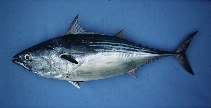添加你自己的观测位置在 Fish Watcher
| Native range | All suitable habitat | Point map | Year 2050 |

|
| This map was computer-generated and has not yet been reviewed. |
| Euthynnus lineatus AquaMaps Data sources: GBIF OBIS |
Colombia country information
Common names:
Atún patiseca, Bonito, Patiseca
Occurrence: native
Salinity: marine
Abundance: | Ref:
Importance: commercial | Ref: To be filled, 1997
Aquaculture: | Ref:
Regulations: | Ref:
Uses: no uses
Comments: Also Ref. 36754.
National Checklist:
Country Information: https://www.cia.gov/library/publications/resources/the-world-factbook/geos/co.html
National Fisheries Authority:
Occurrences: Occurrences Point map
Main Ref: Collette, B.B. and C.E. Nauen, 1983
National Database:
Occurrence: native
Salinity: marine
Abundance: | Ref:
Importance: commercial | Ref: To be filled, 1997
Aquaculture: | Ref:
Regulations: | Ref:
Uses: no uses
Comments: Also Ref. 36754.
National Checklist:
Country Information: https://www.cia.gov/library/publications/resources/the-world-factbook/geos/co.html
National Fisheries Authority:
Occurrences: Occurrences Point map
Main Ref: Collette, B.B. and C.E. Nauen, 1983
National Database:
Common names from other countries
分类 / Names 俗名 | 同种异名 | Catalog of Fishes(属, 种) | ITIS | CoL | WoRMS | Cloffa
Teleostei > Scombriformes (Mackerels) > Scombridae (Mackerels, tunas, bonitos) > Scombrinae
Etymology: Euthynnus: Greek, eu = good + Greek, thynnos = tunna (Ref. 45335).
Etymology: Euthynnus: Greek, eu = good + Greek, thynnos = tunna (Ref. 45335).
Environment: milieu / climate zone / depth range / distribution range 生态学
分布 国家 | FAO区域 | 生态系 | 标本纪录 | Point map | 简介 | Faunafri
Eastern Pacific: off San Simeon, California, USA southward to the Galapagos Islands and northern Peru. Two stray specimens collected in the Hawaiian Islands.
東太平洋: 外海的桑河 Simeon, 美國加州向南至加拉巴哥群島與祕魯北部。 二件迷途的標本收集了在夏威夷群島。
東太平洋: 外海的桑河 Simeon, 美國加州向南至加拉巴哥群島與祕魯北部。 二件迷途的標本收集了在夏威夷群島。
大小 / 重量 / 年龄
Maturity: Lm ? range ? - ? cm
Max length : 84.0 cm FL 雄鱼/尚未辨别雌雄; (Ref. 168); common length : 60.0 cm FL 雄鱼/尚未辨别雌雄; (Ref. 9340); 最大体重: 9.1 kg (Ref. 168)
Max length : 84.0 cm FL 雄鱼/尚未辨别雌雄; (Ref. 168); common length : 60.0 cm FL 雄鱼/尚未辨别雌雄; (Ref. 9340); 最大体重: 9.1 kg (Ref. 168)
简单描述 检索表 | 型态特徵 | 形态测量图
背棘 (总数) : 10 - 15; 臀鳍软条: 11 - 12; 脊椎骨: 37. Anterior spines of first dorsal fin much higher than those mid-way, giving the fin a strongly concave outline. Interpelvic process small and bifid. Body naked except for corselet and lateral line. Swim bladder absent. A large rounded protuberances on 31st and 32nd vertebrae. Color is generally iridescent blue with black dorsal markings composed of 3 to 5 horizontal stripes. Also with variable black or dark gray spots above the pelvic fins. Occasionally with extensive longitudinal stripes of light gray on belly; some individuals have few or no belly markings.
第一背鳍的前面棘比那些中间者高许多, 给鳍一强烈地凹曲轮廓。 腹鳍间的突起小而两裂的。 身体裸露的除了甲胄与侧线。 泳鳔不存在。 在第 31 与第 32个脊椎骨上的一个大的圆形突起。 色彩是通常蓝色虹彩的有黑色的背部斑纹组成物为 3 到 5条水平的斑纹。 也有可变的黑色或者在腹鳍上面的深灰色斑点。 偶然地以广泛纵向斑纹淡灰色的在腹面上; 一些个体有很少或没有腹面斑纹。
第一背鳍的前面棘比那些中间者高许多, 给鳍一强烈地凹曲轮廓。 腹鳍间的突起小而两裂的。 身体裸露的除了甲胄与侧线。 泳鳔不存在。 在第 31 与第 32个脊椎骨上的一个大的圆形突起。 色彩是通常蓝色虹彩的有黑色的背部斑纹组成物为 3 到 5条水平的斑纹。 也有可变的黑色或者在腹鳍上面的深灰色斑点。 偶然地以广泛纵向斑纹淡灰色的在腹面上; 一些个体有很少或没有腹面斑纹。
Occurs rarely where surface temperatures fall below 23°C. Its larvae are more frequently encountered at temperatures above 26°C and are practically confined to waters within about 240 miles off the mainland. Inhabits near the surface of coastal waters and offshore waters (Ref. 11035). Form multi-species schools with Thunnus albacares and Katsuwonus pelamis. An opportunistic predator which shares feeding pattern with other tunas and probably compete for food with other species such as yellowfin tuna, common dolphin, oriental bonito, among others.
很少地生存在哪里表面的温度低于 23个 ° C. 它的仔鱼更时常在 26 °C 上面的温度被见到而且实际地被局限于水域大约在在大陆外 240 哩处之内。 栖息在沿岸水域与离岸水域的表面附近。 (参考文献 11035) 以 黄鳍鲔[Thunnus albacares] 与 正鲣[Katsuwonus pelamis] 形成多鱼种的鱼群。 和其他的鲔鱼与可能分享食物的一个随机的掠食者与其他的种竞争食物例如黄鳍鲔鱼,海豚, 东方的鲣, et。
很少地生存在哪里表面的温度低于 23个 ° C. 它的仔鱼更时常在 26 °C 上面的温度被见到而且实际地被局限于水域大约在在大陆外 240 哩处之内。 栖息在沿岸水域与离岸水域的表面附近。 (参考文献 11035) 以 黄鳍鲔[Thunnus albacares] 与 正鲣[Katsuwonus pelamis] 形成多鱼种的鱼群。 和其他的鲔鱼与可能分享食物的一个随机的掠食者与其他的种竞争食物例如黄鳍鲔鱼,海豚, 东方的鲣, et。
Life cycle and mating behavior 成熟度 | 繁殖 | 产卵场 | 卵 | 孕卵数 | 仔鱼
東太平洋: 外海的桑河 Simeon, 美國加州向南至加拉巴哥群島與祕魯北部。 二件迷途的標本收集了在夏威夷群島。
主要参考文献
Upload your references | 参考文献 | 合作者 : Collette, Bruce B. | 合作者
Collette, B.B. and C.E. Nauen, 1983. FAO Species Catalogue. Vol. 2. Scombrids of the world. An annotated and illustrated catalogue of tunas, mackerels, bonitos and related species known to date. Rome: FAO. FAO Fish. Synop. 125(2):137 p. (Ref. 168)
对人类的威胁
无害处的
人类利用
渔业: 低经济; 游钓鱼种: 是的
FAO(渔业: 产生; publication : search) | FIRMS (Stock assessments) | FishSource | 周边海洋
更多信息
Population dynamics
成长参数
Max. ages / sizes
Length-weight rel.
Length-length rel.
体长-频率
Mass conversion
入添量
丰度
成长参数
Max. ages / sizes
Length-weight rel.
Length-length rel.
体长-频率
Mass conversion
入添量
丰度
Anatomy
鳃区
Brain
Otolith
鳃区
Brain
Otolith
Physiology
Body composition
Nutrients
耗氧量
游泳类型
游泳速度
Visual pigments
Fish sound
Diseases & Parasites
Toxicity (LC50s)
Body composition
Nutrients
耗氧量
游泳类型
游泳速度
Visual pigments
Fish sound
Diseases & Parasites
Toxicity (LC50s)
Genetics
遗传学
Heterozygosity
遗传率
遗传学
Heterozygosity
遗传率
工具
E-book | 野外调查 | 长度- 频率 Wizard | 生活- 历史的工具 | 分布图 | Classification Tree
| Catch-MSY |
特别资料
下载 XML
网络资源
Aquatic Commons | BHL | Cloffa | Websites from users | 核实 FishWatcher | CISTI | Catalog of Fishes(属, 种) | DiscoverLife | ECOTOX | Faunafri | Fishtrace | GenBank(基因组, 核苷酸) | GloBI | GOBASE | | Google Books | Google Scholar | Google | IGFA World Record | MitoFish | OsteoBase(skull, spine) | Otolith Atlas of Taiwan Fishes | PubMed | Reef Life Survey | Scirus | SeaLifeBase | 树状分类阶层 | Wikipedia(转至, 搜寻) | World Records Freshwater Fishing | Zoobank | 动物学的记录
Estimates based on models
Preferred temperature (Ref. 115969): 21.3 - 28.6, mean 26 (based on 34 cells).
Phylogenetic diversity index (Ref. 82804): PD50 = 0.6250 [Uniqueness, from 0.5 = low to 2.0 = high].
Bayesian length-weight: a=0.01148 (0.00591 - 0.02229), b=3.08 (2.92 - 3.24), in cm Total Length, based on LWR estimates for this species & (Sub)family-body (Ref. 93245).
营养阶层 (Ref. 69278): 3.8 ±0.60 se; based on food items.
回复力 (Ref. 120179): 中等的, 族群倍增时间最少 1.4 - 4.4年 (Assuming tm=2).
Fishing Vulnerability (Ref. 59153): High vulnerability (57 of 100).
Climate Vulnerability (Ref. 125649): Very high vulnerability (88 of 100).




